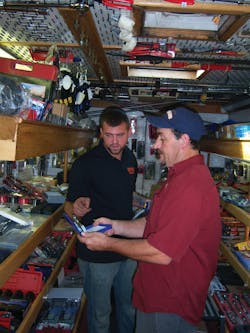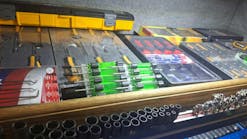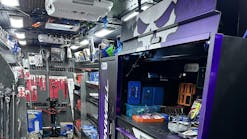Distributor Fine Tunes Winning Formula In Rural Ohio
Start talking tools with John Streber and it’s hard to get him to stop. He is full of stories from his 42 years of selling tools in rural, southwestern Ohio. “I like everything about the tool business,” he says.
The animated, 68-year-old Streber remains as passionate about tools as ever. And it shows in the team he has developed around him at Quality Craft Tools Inc. The 3,300-square-foot warehouse located on a 75-acre parcel in Hillsboro, 60 miles west of Cincinnati, supports two tool trucks serving the immediate 100-mile radius, and several truck trailers that travel to farm equipment trade shows across several states.
The combined focus on tool trucks and farm trade shows has proven a winning formula for Quality Craft Tools in a part of the country that has suffered severe economic losses in recent years. In addition to the pressures from the recession, southwestern Ohio took a blow in 2009 when DHL, the international courier, closed its distribution hub in Wilmington, Ohio, laying off 8,000 employees and idling numerous other businesses dependent on the distribution hub. Clinton County unemployment currently stands at 10.5 percent.
Streber is proud of the fact that his tool truck sales have held steady during this tumultuous period. He credits the success to the team he has developed, including his nephew, Steve Streber, office manager, his great nephew, Schuyler Streber, the IT manager, and John Rhoads, his protégé of 20 years who shares with him responsibility for tool truck sales and farm show sales.
The dual focus on tool trucks and trade shows has enabled the company to grow sales in double digits every year since the recession struck in 2008. To support continued growth, Streber recently built a second, 7,200-square-foot warehouse on his property.
Understand the customer’s needs
Streber learned early on that by understanding his customers’ needs, he could offer the products they need when they need them. “By doing this, we can get a better profit on our products compared to our competitors,” he notes.
Years ago, Streber and his brother, Bo, developed a technique that would serve them well for years to come; packaging groups of small tools in bundles. “We can just sell more if it’s bundled. Present it that way and a lot times they’ll take the whole thing.”
He developed a “bargain box,” in which incomplete sets of products are kept along with slow selling items. “Bargain box” items are sold at a discount.
He made it a practice of passing out wholesaler catalogs with his own company’s logo and phone number on it. This way, a customer can call him and place an order. Streber either takes credit card payment over the phone or sends an invoice, then has the wholesaler ship the order direct to the customer. He doesn’t have to inventory the product himself.
Streber does not encourage customer financing; most sales are cash.
Steady growth and challenges
Streber’s tool business grew through the 1980s, as many of the service station mechanics he sold to opened their own repair shops.
Business also became more challenging during this period as mass merchants, home centers and super centers expanded their tool offerings and put many tool dealers out of business.
Realizing he needed to cover more territory, he invested in a larger truck, and opened a flea market store at Caesar’s Creek Flea Market near Wilmington, Ohio. He had his company logo hand painted on the truck. The bigger truck allowed him to display more merchandise. Every shelf has its own merchandise groups.
Expansion into farm shows
In the early 1990s, Streber exhibited at his first farm show. He realized that farm shows offered a new venue to sell at. But there were logistical issues to consider. To haul merchandise to farm shows, trailers and box trucks were needed for carrying pallet jacks and dollies in addition to merchandise.
Depending on when and where a show was held, he had to consider his tool truck route schedule. Streber realized he needed help to continue his existing tool truck business and expand into farm shows.
His nephew, Steve, soon came on board to help with organizing inventory and managing the books.
In 1992, John Rhoads knocked on his door and asked him if he had any work for him. Streber hired Rhoads to paint his roof. He then gave him other jobs, including helping him assemble merchandise to be sold at the flea market.
Rhoads was reluctant to become a tool truck driver because he didn’t see himself as a salesman. But he eventually agreed to give it a try.
Streber assigned Rhoads his Ohio routes and continued to run the Kentucky routes himself. He started Rhoads with a cargo van, but progressively upgraded him to larger vehicles.
Streber developed a detailed inventory check list for Rhoads to fill out. Every product has a stock number, cost, starting inventory date, ending inventory date, sale price, taxes, credit card fee (if applicable), insurance cost and profit.
Organization: a tool in itself
Streber and Rhoads each have a total of five tool truck routes. They run each route every two or three weeks. They believe deliveries every two or three weeks is more profitable than visiting customers weekly, as some of their tool truck competitors do.
Rhoads says that as long as the customers know when to expect him and he shows up when expected, he can make more sales. He gives his customers a catalog and tells them what day to expect him next.
Rhoads learned to carry a book with him to keep track of things customers ask for if they don’t find it on his truck. “These guys will tell you what they need,” he says.
Most customers are automotive repair shops. There are also scrap yards and outdoor power equipment dealers. One of Rhoads’ larger customers is a farm equipment store where he not only sells to mechanics. He also manages a tool display section in the store’s showroom.
Expanding from an 18-foot truck to a 22-foot Grumman truck recently allowed Rhoads to double the number of stock keeping units he carries and allows as many as 10 people inside the truck at a time. He claims his sales have grown as a result of having a larger truck.
Suppliers play a key role
Another key to success, according to Streber, is having good supplier sales reps to work with. For instance, he appreciates the fact that his sales rep Jody Curry at Neu Tool & Supply can get him pricing and inventory information quickly over the phone. The company’s main wholesalers also include Ace Tool Co. and Integrated Supply Network Inc.
Rhoads, like Streber, has gained some good repeat customers from the farm shows he works. He met a farm equipment dealer at a show in Minnesota who called him one day looking for a way to resupply a farm service truck that had gotten low on tools. Rhoads was reluctant to drive his truck to Minnesota, so he faxed his inventory to the dealer and asked him what he needed. When the dealer indicated he needed at least $6,000 worth of tools, Rhoads obliged him and drove to Minnesota and was well rewarded for it.
Rhoads has also learned the importance of going out of his way to please the customer. There have been instances when customers ask him to replace a faulty tool, mistakenly thinking he sold it to them. If Rhoads believes the customer sincerely believes he sold the tool, he replaces it. “There’s no sense in arguing. It’ll cost you thousands of dollars if you don’t give it to him. He’s going to remember you if you took care of him.”
Meanwhile, Streber’s goal is to hire more drivers that can work for him, similar to how Rhoads does. He is actively seeking new drivers.
Four years ago, the company launched a Website, www.qualitycrafttools.com. The Website lists the company’s best sellers and allows customers to place their orders by calling their toll free phone number. The company expects the Internet to become a bigger part of the business in the future.
The biggest challenge in the near term for Quality Craft Tools is fuel prices. Not only do they eat into the company’s profits; they leave customers with less money to spend on tools.
Versatile youth experience prepared Streber for success in tool sales. But for Quality Craft Tools, the future remains upbeat. Service technicians need reliable tools to do their jobs efficiently.
Streber considers himself lucky to have found a vocation he feels passionate about. For newcomers in any business, he offers the following advice: “If you’ve got a passion follow it and you’ll do well.”
Top 5 selling tools
Cargo straps (private label)
Socket sets (Tekton by MIT)
Air tools (Ingersoll Rand)
Punches and chisels (Sargent Tools)
Gloves (B & G Gloves)
Top 5 selling tools
Cargo straps (private label)
Socket sets (Tekton by MIT)
Air tools (Ingersoll Rand)
Punches and chisels (Sargent Tools)
Gloves (B & G Gloves)


